Under the tarmac of Madrid
Under the tarmac of Madrid
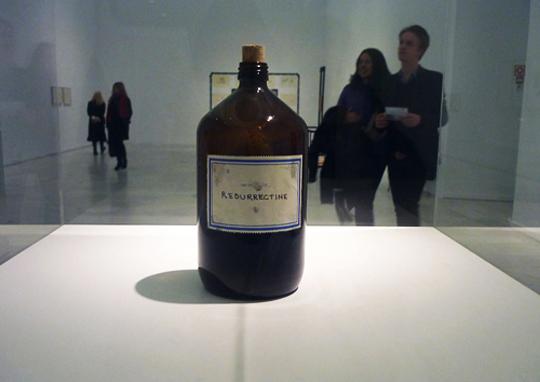
February in Madrid means the whole art scene bursting: the international Art Fair Arco opened for its 31st edition, and so did Art Madrid and the more alternative Flecha or Justmad.
But all this excitement in the official art dates is not keeping everybody distracted. Almost one year after the Spanish Spring, people are still reflecting upon what happened and why it is still happening. And this debate also touches on the art.
A change in the political power, an economical crisis, a visible gentrification process and an ever-growing dystopic urban landscape (the council is filling every street corner with huge blocks of concrete)... are the background for Madrid's current art scene.
The pope's visit, while people hurrying a revolution in the streets, is just one of the crazy dichotomies happening here. Because in what comes to cultural politics, these seem to be nothing less but twisted. Or how would you describe a goverment that sponsors such activities (the pope festivities) and through other public institutions wants to collaborate with... squats?.
In my search for art spaces I happened to find out that sometimes opposite worlds just converge, a.k.a.: institutions are keenly approaching the underground scene to work together in terms of art. This new vision of institutionalization can be positive, as long as an abuse or an inadequate approach of social movements is not produced out of that symbiosis.
But first things first. To put me up-to-date, I had to start my research with mandatory visits to institutions such as MNCARS, indisputably one of the leading centers for contemporary art in Europe. I arrived on time to catch the first retrospective about Raymond Roussel ever celebrated in the country, and Antoni Muntadas' Entre/Between (on view till the end of the month).
The new arrangement of the museum collection, initiated by Borja-Villel two years ago, counts with such appealing room titles as The Irruption of the 20th Century: Utopias and Conflicts.
What it is still surprising is the fact that despite of the cuts in the culture budget the entrance to public museums on late hours is still free. Will this little luxury last forever?. Just remember what happened to the Staatliche Museen about two years ago.
And the literary beat goes on... Círculo de Bellas Artes is showing another intriguing literary personality. With an array of visual documents accompanied by media works (e.g. the film Un homme qui dort), it is quite a joy to approach Georges Perec through this exhibition.
Another Madrid-must, La Casa Encendida, is currently exhibiting both well-known and emerging artists from Holland in A Dutch Landscape, a groupshow that combines elements that swing from slapstick to more pseudo-existentialist poetics, including names such as Bas Jan Ader, Feiko Beckers or Navid Nuur.
Later that day, I had the biggest fun gazing at some puzzled visitors gathering around Martin Creed's crumpled Din A4, while the guards of the Sala Alcalá 31 got their peak of action for the day by stopping all my attemps to take illustrative pictures of such scene. They won, as you can notice.
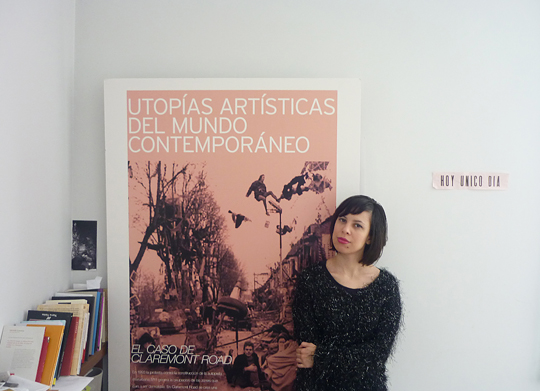
Julia Ramírez Blanco is a researcher and activist who sees herself in between worlds, or just wherever she can participate. As a scholar in residence at the legendary Residencia de Estudiantes, this art historian is currently working on a book about Utopias in Art.
In her opinion, Madrid is "quite the place to be right now, because things are happening". While in Barcelona the cultural activity seems to be louder, the fact that the current political powers are rather oppressing here is actually bringing people together and, as a result, a higher commitment and tighter networks, as the 15M movement has already proven.
Co-founder member of Collectif Tururú, Julia has been also organizing a series of activities like concerts in laundromats and other actions in public spaces.
Matadero is an experimental institution working with artists, NGO's, associations and residents from the Legazpi area since 2007. Housed in a former abattoir and directly depending on the council fonds, this center for contemporary creation hosts a Design Center, a reading space, the Cineteca... and counting, because they are still developing new and exiciting projects.
David de Rozas from Intermediae told me about their practices in a space flooded with light and fancy designs that would never hint that you are in the former refrigerator of this abattoir.
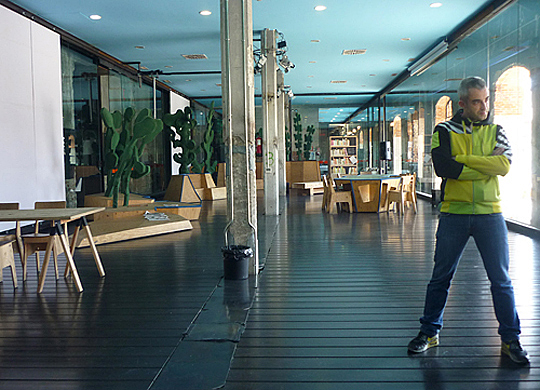
David at Terrarium
An archive of video games, an interactive seedbank, or the Avant-Garden designed by Berlin-based Atelier Le Balto are some of the activities that they offer, along with Mataderos's regular program of exhibitions, theater and cinema.
The politics of exchange, collective creation, sustainability and permaculture are main target lines for Intermediae. Conceived as a place for social encounter, they got regulars who come by for collaborative working, reading publications, or just enjoying a coffee at the Terrarium designed by Anthony Kleinepier.
Goin' down south...
… I'm going down south, to check Lavapies (literal: feet washer). Traditionally considered a slum area, a rising process of gentrification is slowly kicking in this suburban neighborhood where political activists coexist with drug dealers.
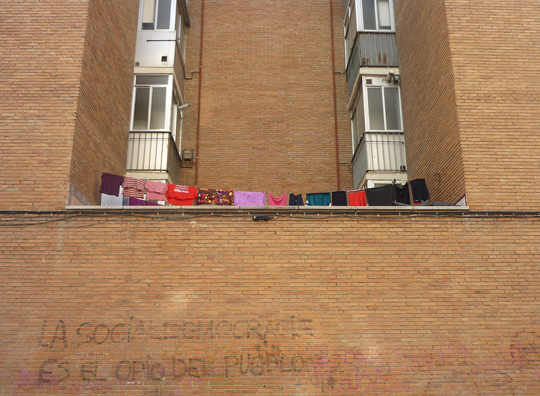
Washed out graffiti in the streets of Lavapies that reads Social-democracy is the opium of the people
After a little walk with a suburban taste, I arrived at Tabacalera for a chat with Jordi Claramontes under a hitting sun. I asked him to explain me what they are doing in this former cigarette factory, since I have been hearing it mentioned quite often.
And so the story goes... the ministry had a project for an audiovisual center that due to a wrong handling, a semi-intentional delay, and the menace of a brewing crisis got the mission aborted. And so Tabacalera opens with a permission for exhibitions right before the crisis can be really noticed. Or how master of metaphores Jordi describes it: “the crisis is like a samurai with the head freshly chopped off”.
Tabacalera was conceived as a total center for arts and culture focusing in the social aspect, counting with additional services such as a bike workshop or a kindergarden. The fact that they are an art collective with the typical (a?)political structure of a squat can lead to some certain aesthetics like street art, or gardening, which I'm quite aware of as we're sitting in the yard and skaters pass by.
Jordi, who comes from the activist milieu from Lavapies and works with globalisation and such topics, understands the duty of self-managing as an artwork itself, since running a space this way is like organizing a continuous groupshow.
Radical yet elegant is how Papel de Fumar (smoking paper) presents itself. Tabacalera's editorial project follows the motto “ Enthusiasms is what runs promotion”, meaning by that, that authors can organize themselves to get published, with no need of an editorial committee and their marketing strategies. Another example of Tabacalera's d.i.y. philosophy.
Carabanchel bound
Just for you to get the picture, as we are going deeper down in the south of the city, we might find some resemblance with the recent evolution of Neukölln. Because things seem to be brewing around here, and many artists studios have been recently popping out in the area, only that the gentrification process goes much slower here than in Berlin.
Rampa (spanish for ramp) was born in 2009 as a space focusing on independent production. I was lucky enough to catch multitasker Antonio, co-founder member of the project who is also a scholar at the Students Residence and works as a teacher at the European Institute of Design in Madrid. Antonio, who has previously taken part in other art collectives, claims that the members of Rampa are just following a common goal: to generate debates in an interdisciplinary space for development and cultural exchange.
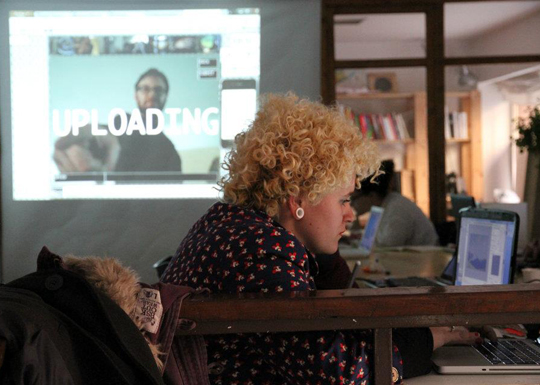
Formato GIF Workshop. Picture courtesy of Rampa
Completely unrelated from any institutional organism and depending on their personal budget, Rampa intends to keep working as a non-profit organisation, however any kind of economical help would always be welcome, since the goal is to make it sustainable.
Their projects comprise a library, technical workshops for artists, a series of artists presentations called Ladies and Gentlemen..., or the editorial Ortomatica, while they are also working on parallel ways of combining science and art.
They offer different working programs at their space, and an annual international residency for artists, in collaboration win felipaManuela.
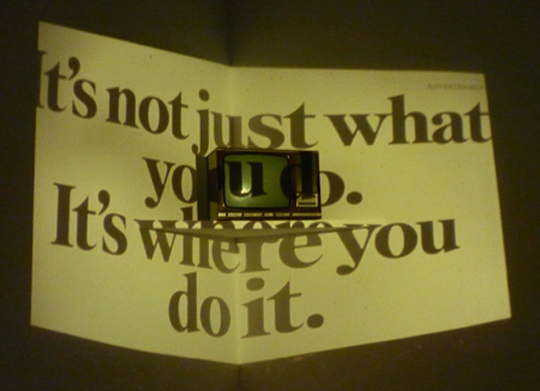
Antoni Muntadas, Entre/Between at MNCARS
Here, just an attempt of a portrait of the Madrid scene through some of their protagonists. A task that has been quite easy since most of them seamed to agree in which places were the most important and how in some way they are all related. A good example of good networks and communication.
However I often heard negative critiques. And different voices were saying the words “conformism”,“deillusion” and “leaving” around glasses of vermouth these days, but such conversations sometimes led to more optimistic ideas, as the fact that such a punk city can also generate a lot of movement and revolt.
We'll keep our ears open, and our fists raised, when needed.